Commercial Building Surveys in East Devon and Exeter
Our chartered RICS surveyors have extensive local experience of the East Devon and Exeter commercial property landscape.
East Devon, and neighbouring Exeter, are remarkably diverse in their commercial properties.
As well as the numerous hospitality properties lining the stunning coastline, the area is home to cutting-edge centres like Exeter Science Park, large industrial units such as those around Cranbrook and Greendale, attractive business complexes such as those in Topsham and retail units in towns such as Exmouth and Axminster.
The contrast between the properties, from historic public houses in rural villages and contemporary office buildings in Exeter, makes for some fascinating surveying work.
Recent examples
Building survey of a 19th century courthouse
- This was a condition survey undertaken for the local authority, who own and manage the building.
- The property was Grade II listed and built using traditional masonry. It was predominantly coursed random rubble with dressed stone reveals and ‘bullseye’ high-level lights. There was a more modern brick extension to the rear.
- The property had been multi-occupancy, and so internally the use of the various spaces was varied, from staff kitchens to office spaces and catering facilities.
- Externally, the size of the building meant that we needed to use a drone to assess the roof.
- A thorough assessment of any roof is important, and flat roof areas in particular can deteriorate fairly quickly.
- If unadressed, deterioration of the roof can lead to water ingress and internal damp and rot. Therefore, it’s crucial to carry out roof repairs before starting on internal repairs and decoration. Otherwise the damp will persist and the internal issues will return.
Properties like this have numerous period features, such as stone archways and original chimney stacks. These need careful and sympathetic maintenance and repair.
It’s important to carry out such repairs and maintenance using appropriate materials – a lime mortar mix should be used for repointing in this case.
Because the property is Grade II listed, building conservation must be consulted before making any changes that affect the appearance or historic interest of the building. This would include improving insulation or upgrading fire doors.
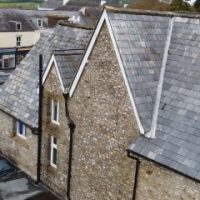
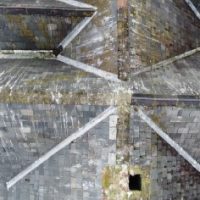
Condition survey of a chapel
This chapel was single storey and comprised of coursed random rumble
construction with buttress support and pitched roofs with slate tile coverings.The roof was particularly interesting, with a bell tower and ornate stone features.
Structures like this need careful maintenance to maintain them in a functional state for future generations. Here, the mortar joints to the parapet coping stones needed repointing, the bedding of the ridge tiles needed to be filled, and a number of slipped tiles needed to be re-fixed.
External timber is common in such buildings, and in this case was used for doors and decorative panelling.
Cyclical redecoration is recommended for external timerb to keep it in good condition and decorative order.
Limestone, like that used in this chapel’s construction, is prone to water damage. Adequate drainage is critical for preventing rainwater saturation and penetration.
For this reason, vegetation growth is a common issue because it hampers the efficacy of drains and rainwater goods. Drainage facilities need to be regularly cleared and well maintained, which will in turn contribute to the maintenance of the stonework.
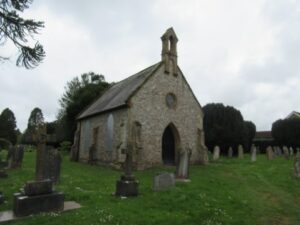

Read more about our condition surveys here, or find out more about our other commercial surveying services in East Devon and beyond.
Want to know more?
Structural roof assessment of a leisure centre
Our client was installing PV panels over the monopitch roof of a swimming pool building.
We visited the site to inspect the roof structures and establish the existing loading due to roof cladding, suspended services, etc.
We then carried out a load assessment for the roof structures to calculate the increased loading and the capacity of the existing structure, and calculated wind and snow loads on the roofs in accordance with National Annex to BS EN 1991-1-4:2005 UK National Annex to Eurocode 1 – Actions on structures Part 1-4.
The age of roofs like this mean that they were designed British Standard Code of Practice CP3 Chapter Five, Part 1: Dead and Imposed Loads.
Section 6.2 of CP3 identifies that for flat roofs where no access is provided to the roof (other than that necessary for cleaning and repair) the imposed load allowance including snow is to be 0.75kN/m2 measured on plan, or a point load of 0.9kN concentrated on a 300 x 300mm square.
In accordance with more recent Eurocodes and British Standard BS 6399: Part 3: 1988 Loading for Buildings – Code of Practice for Imposed Roof Loads, this minimum imposed load requirement has been reduced to 0.60kN/m2.
Assuming the PV panels are fragile and will not be walked on, the roof areas where the PV is installed will not experience imposed loading other than snow.
On this basis it is reasonable to take advantage of the difference between the original design imposed load and the calculated snow load.
Therefore in practical terms, there is often no net increase in roof loading relative to the original design loads on such roofs.
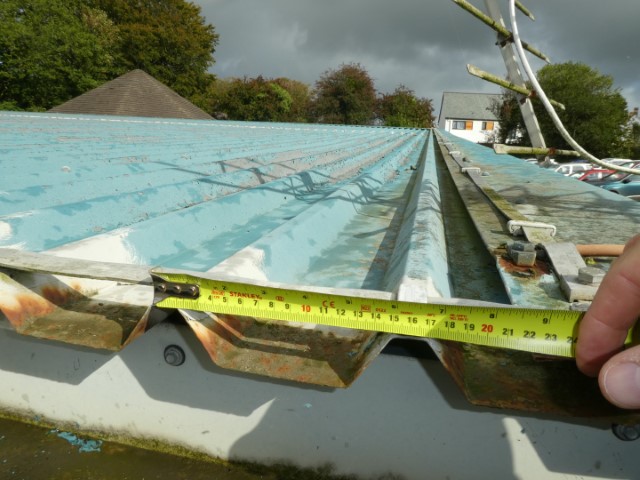
Roof calculations for large warehouse building
This warehouse had two wings.
One had pitched steel trusses at 3.25-4.0m centres, cantilevering off primary parallel chord trusses
The other was a simple portal frame with a flat roof. There were no ceilings in this part of the building building and suspended services are typically limited to lighting.
We were instructed to check whether the first wing could support replacement cladding, and inform client of load capacity of second wing roof.
One of the roofs had valleys.
These need to be taken into account because there is a potential for snow drift to occur.
We looked for any areas where purlins would be overstressed when subjected to the dead, imposed and wind load combination. In such cases, we would recommend that they were replaced, and detail a suitable specification.
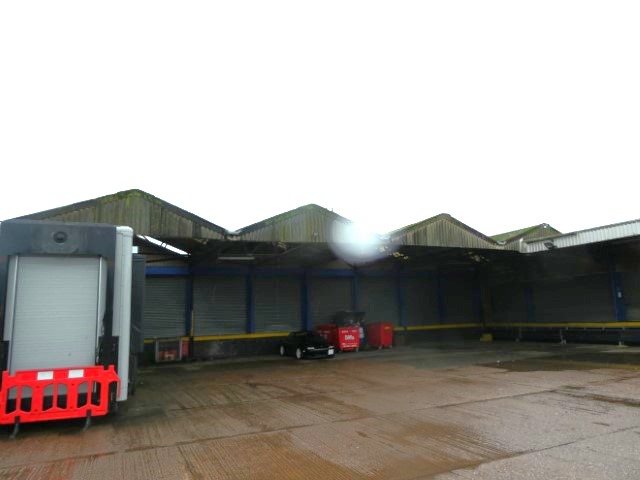
Read more about our other commercial surveying services in East Devon and beyond.
We're here to help
If you would like to discuss a potential project with our consultants or get advice on any aspect of building surveying or engineering, please don’t hesitate to complete our contact form, call us on 0333 202 6386, or contact one of our regional offices.



